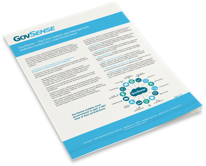GovSense for Local Government GIS Departments
Technology that integrates seamlessly with Esri
to give you complete geo-spatial information.
The bi-directional integration to Esri is at the core of GovSense and is fundamental to our entire software solution
GovSense provides a seamless local government GIS experience. A geographic information system (GIS) helps gather, manage and analyze data. GIS is rooted in the science of geography and integrates into various data types. It analyzes spatial location and organizes multiple layers of information into visual renderings using maps and 3D scenes. With this unique capability, GIS reveals deeper insights into data, such as situations, patterns and relationships. Jurisdictions then use this geo-spatial data to make informed decisions and build smarter communities.
Geographic information is the key to smarter decision-making…
…almost everything a jurisdiction does, whether in day-to-day or long-term planning, revolves around geography. Not only can GovSense’s local government GIS module leverage and display the information on a web map, but it also interacts with the multitude of layers behind the scenes, connecting financial data with geographic data. This multilayered information is readily available on any device, mobile phone or tablet at any time.
GIS can be used to streamline internal processes as well play a vital role in Planning, Economic Development and Infrastructure decisions. Our local government GIS program can help improve workflows across departments by providing you with data to solve real world problems like managing your fleet, tracking work orders or mapping streets . Mapping software is beneficial for any jurisdiction. GovSense GIS software supports both ArcGIS online and ArcGIS server.


GovSense GIS software enables jurisdictions to:
- Bring spatial data and spatial analysis to the general ledger, thereby gaining a 360-degree view of a person, parcel or transaction.
- Increase data visibility that eliminates redundant reports and removes unnecessary bottlenecks.
- Configure and tailor their integration to fit their community’s unique needs.
- Leverage spatial data for non-traditional purposes such as planning and budgeting or economic development initiatives.
- Build out workflows to run analyses on spatial data and to write business rules leveraging spatial data in the graphic workflow engine.

 DATA SHEET:GovSense Land Management
DATA SHEET:GovSense Land Management